
Fort William formerly and, , formerly is a town in Lochaber in the Scottish Highlands, located on the eastern shore of Loch Linnhe. At the 2011 census, Fort William had a population of 10,459, making it the second largest settlement in both the Highland council area, and the whole of the Scottish Highlands; only the city of Inverness has a larger population.

Back of Keppoch is a small coastal settlement in the northwest Scottish Highlands, 40 miles west of Fort William near to the A830 road to Mallaig.
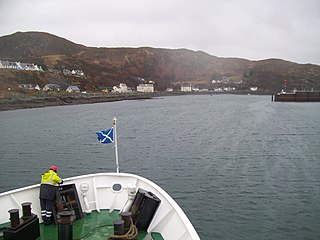
Mallaig is a port in Lochaber, on the west coast of the Highlands of Scotland. The local railway station, Mallaig, is the terminus of the West Highland railway line and the town is linked to Fort William by the A830 road – the "Road to the Isles".

The West Highland Line is a railway line linking the ports of Mallaig and Oban in the Scottish Highlands to Glasgow in Central Scotland. The line was voted the top rail journey in the world by readers of independent travel magazine Wanderlust in 2009, ahead of the notable Trans-Siberian line in Russia and the Cuzco to Machu Picchu line in Peru. The ScotRail website has since reported that the line has been voted the most scenic railway line in the world for the second year running.

Corrour railway station is on the West Highland Line, near Loch Ossian on the Corrour Estate, in the Highland Region of Scotland. It is the highest mainline railway station in the United Kingdom. It is located between Rannoch and Tulloch, and is sited 71 miles 54 chains (115.3 km) from Craigendoran Junction, near Helensburgh. ScotRail manage the station and provide most services, along with Caledonian Sleeper.
Arisaig is a village in Lochaber, Inverness-shire. It lies 7 miles south of Mallaig on the west coast of the Scottish Highlands, within the Rough Bounds. Arisaig is also the traditional name for part of the surrounding peninsula south of Loch Morar, extending east to Moidart. Etymologically, Arisaig means "safe bay". It lies in the Scottish council area of Highland and has a population of about 300.

Morar is a small village on the west coast of Scotland, 3 miles (5 km) south of Mallaig. The name Morar is also applied to the northern part of the peninsula containing the village, though North Morar is more usual. The coastline of the area forms part of the Morar, Moidart and Ardnamurchan National Scenic Area, one of 40 such areas in Scotland, which are defined so as to identify areas of exceptional scenery and to ensure its protection by restricting certain forms of development.
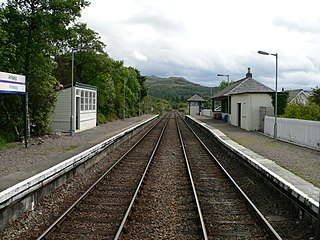
Arisaig railway station serves the village of Arisaig on the west coast of the Highland region of Scotland. This station is on the West Highland Line, measured 32 miles 2 chains (51.5 km) from the former Banavie Junction, near Fort William, between Beasdale and Morar on the way to Mallaig. The westernmost station on the Network Rail network, it is the only one of the four cardinal points of the national network that is not a terminus. ScotRail, who manage the station, operate all services.
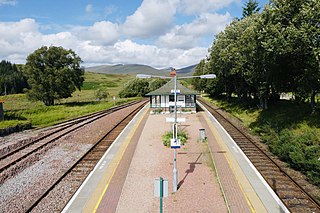
Rannoch railway station, on the West Highland Line, serves the area of Rannoch in Perth and Kinross, Scotland. In 2017, Simon Jenkins reported it to be one of the best 10 stations in Britain. It is situated between Corrour and Bridge of Orchy, 64 miles 36 chains (103.7 km) from Craigendoran Junction, near Helensburgh. ScotRail manage the station and operate most services, along with Caledonian Sleeper.
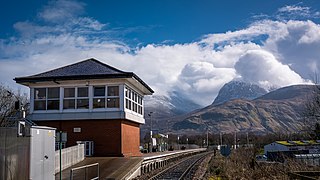
Banavie railway station is a railway station on the West Highland Line serving the village of Banavie, although it is much closer to Caol, Scotland. It is sited between Corpach and Fort William, 0 miles 22 chains (0.44 km) from Banavie Junction, just north of Fort William. To continue on to the next station at Corpach, trains must pass over the Caledonian Canal at Neptune's Staircase, a popular tourist attraction. ScotRail provide all services at, and manage, the station.
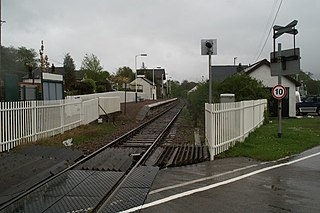
Corpach railway station is a railway station serving the village of Corpach in the Highland region of Scotland. This station is on the West Highland Line, between Banavie and Loch Eil Outward Bound, and is sited 1 mile 30 chains (2.2 km) from Banavie Junction, near Fort William. ScotRail, whop manage the station, operate all services.

Loch Eil Outward Bound railway station is a railway station on the northern bank of Loch Eil in the Highland region of Scotland. This station is on the West Highland Line, between Corpach and Locheilside, sited 4 miles 20 chains (6.8 km) from Banavie Junction, near Fort William. ScotRail, who manage the station, operate all services.

Locheilside railway station is a railway station on the northern shore of Loch Eil in the Highland Council Area of Scotland. This station is on the West Highland Line, between Glenfinnan and Loch Eil Outward Bound, located 7 miles 79 chains (12.9 km) from the former Banavie Junction near Fort William. ScotRail, who manage the station, operate all services.

Glenfinnan railway station is a railway station serving the village of Glenfinnan in the Highland council area of Scotland. It is on the West Highland Line, between Lochailort and Locheilside, located 14 miles 58 chains (23.7 km) from the former Banavie Junction. Glenfinnan Viaduct is about 0.7 miles (1 km) to the east of the station. ScotRail, who manage the station, operate all services.

Morar railway station is a railway station serving the village of Morar in the Highland region of Scotland. This station is on the West Highland Line, between Arisaig and Mallaig, 36 miles 59 chains (59.1 km) from the former Banavie Junction, near Fort William. ScotRail, who manage the station, operate all the services here.

Mallaig railway station is a railway station serving the ferry port of Mallaig, Lochaber, in the Highland region of Scotland. This station is a terminus on the West Highland Line, 41 miles (66 km) by rail from Fort William and 164 miles (264 km) from Glasgow Queen Street. The station building is Category C listed. ScotRail, who manage the station, operate most of the services.

The West Highland Railway was a railway company that constructed a railway line from Craigendoran to Fort William and Mallaig. The line was built through remote and difficult terrain in two stages: the section from Craigendoran to Fort William opened in 1894, with a short extension to Banavie on the Caledonian Canal opening in 1895.
"The Road to the Isles" is a famous tune composed by Pipe Major John McLellan DCM which was originally called ‘The Bens of Jura’, though it previously had other titles. It is part of the Kennedy-Fraser collection and it appeared in a book entitled 'Songs of the Hebrides' published in 1917, with the eponymous title by the Celtic poet Kenneth Macleod. The poem is headed by the statement 'Written for the lads in France during the Great War'. The impression is given by the notes appended to the book that the author was Kenneth Macleod himself. Marjory Kennedy-Fraser toured the Western Isles of Scotland in the summer of 1917 and collected a group of local tunes. The tune associated with the Road to the Isles was an air played by Malcolm Johnson of Barra on a chanter and composed by Pipe Major John McLellan of Dunoon. Kenneth Macleod then wrote the words for a voice and harp arrangement of this air by Patuffa Kennedy-Fraser.

Lech-a-Vuie Platform railway station, Lechavuie or Lech-a-Vute was not constructed for public use. It stood close to the A830 road to the east of Loch Eilt near the Allt-a-Ghiughais burn and below Doire Dhamh on the West Highland Railway's extension to Mallaig. It stood in between the still extant Glenfinnan and Lochailort stations. At first it only served the needs of shooting parties on the Inverailort Estate owned by the Common-Head family, however it was later used by the army and navy during WWII and closed in the 1970s. Lech-a-vuie was 18.5 miles (30 km) from Mallaig Junction and stood at the summit of the line at a height of 379 feet.



















